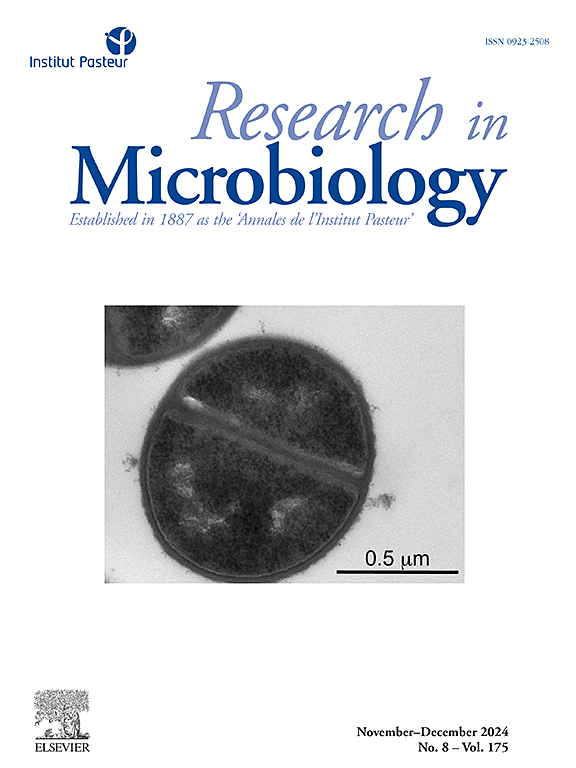CRISPR/Cas9和λ-Red重组系统在鱼腥爱德华菌突变体中的转座元件IS1的转座
IF 3.4
4区 生物学
Q3 MICROBIOLOGY
引用次数: 0
摘要
本研究旨在研究CRISPR/Cas9基因组编辑系统在鱼畔爱德华菌中引入的意外突变。利用CRISPR/Cas9和λ-Red重组系统,对野生型piscicida NH1及其丙氨酸消旋酶敲除突变体piscicida Δalr325 NH1和piscicida Δalr50 NH1进行全基因组测序。比较基因组分析显示,在CRISPR/ cas9编辑的突变体中发生了插入序列1 (IS1)转位,除了靶基因缺失外,还破坏了I型限制性修饰系统M亚基基因。有趣的是,在通过传统的基于质粒的等位基因交换产生的突变体中未检测到IS1转座,这表明CRISPR/ cas9介导的编辑与转座事件之间存在潜在联系。这些结果表明,通过CRISPR/Cas9进行基因组编辑可能引发IS1转位,可能是由于双链DNA断裂。单导RNA (sgRNA)与转座区域之间缺乏序列相似性,表明转座不是CRISPR/Cas9脱靶效应。这项研究提供了移动遗传元件和基因组编辑系统之间相互作用的证据,需要进一步研究其潜在机制。本文章由计算机程序翻译,如有差异,请以英文原文为准。
Transposition of transposable element IS1 in Edwardsiella piscicida mutant generated by CRISPR/Cas9 along with λ-Red recombineering system
This study aimed to investigate unintended mutations introduced by the CRISPR/Cas9 genome editing system in Edwardsiella piscicida. Whole-genome sequencing was conducted on the wild-type E. piscicida NH1 and its alanine racemase knockout mutants (E. piscicida Δalr325 NH1 and E. piscicida Δalr50 NH1) generated using CRISPR/Cas9 with a λ-Red recombineering system. Comparative genomic analyses revealed that the insertion sequence 1 (IS1) transpositions occurred in the CRISPR/Cas9-edited mutants, disrupting the type I restriction-modification system subunit M gene, in addition to the targeted gene deletion. Interestingly, no IS1 transpositions were detected in mutants produced via conventional plasmid-based allelic exchange, indicating the potential link between CRISPR/Cas9-mediated editing and transposition events. These results suggest that genome editing via CRISPR/Cas9 could trigger IS1 transposition, potentially due to double-stranded DNA breaks. The lack of sequence similarity between the single guide RNA (sgRNA) and the transposed regions suggests that transpositions are not CRISPR/Cas9 off-target effects. This study provides evidence of interactions between mobile genetic elements and genome editing systems, requiring further investigation into their underlying mechanisms.
求助全文
通过发布文献求助,成功后即可免费获取论文全文。
去求助
来源期刊

Research in microbiology
生物-微生物学
CiteScore
4.10
自引率
3.80%
发文量
54
审稿时长
16 days
期刊介绍:
Research in Microbiology is the direct descendant of the original Pasteur periodical entitled Annales de l''Institut Pasteur, created in 1887 by Emile Duclaux under the patronage of Louis Pasteur. The Editorial Committee included Chamberland, Grancher, Nocard, Roux and Straus, and the first issue began with Louis Pasteur''s "Lettre sur la Rage" which clearly defines the spirit of the journal:"You have informed me, my dear Duclaux, that you intend to start a monthly collection of articles entitled "Annales de l''Institut Pasteur". You will be rendering a service that will be appreciated by the ever increasing number of young scientists who are attracted to microbiological studies. In your Annales, our laboratory research will of course occupy a central position, but the work from outside groups that you intend to publish will be a source of competitive stimulation for all of us."That first volume included 53 articles as well as critical reviews and book reviews. From that time on, the Annales appeared regularly every month, without interruption, even during the two world wars. Although the journal has undergone many changes over the past 100 years (in the title, the format, the language) reflecting the evolution in scientific publishing, it has consistently maintained the Pasteur tradition by publishing original reports on all aspects of microbiology.
 求助内容:
求助内容: 应助结果提醒方式:
应助结果提醒方式:


